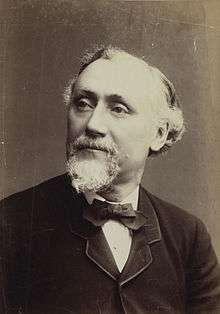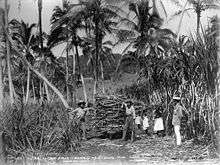Alfred Henry Burton
Alfred Henry Burton (c. 1834 – 2 February 1914) is considered one of New Zealand's most important nineteenth-century photographers.


Burton was born in Leicester, England. His birth year is uncertain and in the biography published by the Ministry for Culture and Heritage, a range from 1833 to 1835 is given.[1] His father, John Burton, was a prominent photographer and his firm John Burton and Sons was patronised by Queen Victoria and other members of the Royal Family.[2]
Burton emigrated to New Zealand in 1868 on the request of his brother Walter John Burton. Walter had set up a photographic studio in Dunedin but inundated with work asked Alfred to join him. Burton travelled extensively within New Zealand for the firm, now called Burton Brothers and built up a strong portfolio of landscape images for the business. He made frequent trips to Fiordland, the Southern Lakes and South Westland.[2]
Despite their initial success, in 1877 Alfred and Walter's partnership came to an acrimonious end. Walter left to visit Europe to acquaint himself with new photographic developments and Alfred took over the firm, employing other talented photographers such as George Moodie and Thomas Muir.[2] In 1884 Burton travelled to the Pacific Islands, including Samoa, Fiji, and Tonga and photographed local people and scenes of village life.
In 1885 and 1886 Burton journeyed into the King Country of New Zealand. These trips occurred in the aftermath of the New Zealand Wars and before the Māori of the region had become used to being photographed. The pictures taken during these trips are considered to be some of Burton's best work because of the ways he perfected ethnographic portraiture and landscape photography. In these photographs Burton promoted both the beauty of the King Country and a vision of Indigenous people that obscured their control over tribal lands.[3]
In 1886 Mount Tarawera erupted, causing loss of life and burying the famous New Zealand tourist attraction the Pink and White Terraces. Burton visited the sites soon after the eruption and rephotographed regions he had previously photographed before the eruption.[2] His photos were employed by researchers who recently rediscovered the locations of the Pink and White Terraces.[4] [5]
Burton continued to travel throughout New Zealand in the 1880s photographing for the Burton Brothers firm. The firm developed strong distribution channels for prints of their work and prints and postcards produced from these photographic series were available commercially through agents and catalogues for contemporary travellers' albums and ethnographic collections. Prints of the work of Burton Brothers are still popular today and original prints are sold at fine art auctions.[2]
Burton retired from photography in 1898. His son, Henry Burton who worked for him as a photographer, was killed in a horse accident in 1901.[2]
Burton came ninth in the three-member City of Dunedin electorate in the 1896 election.[6][7]
Burton died in 1914.[2]
References
- Knight, Hardwicke. "Burton, Alfred Henry". Dictionary of New Zealand Biography. Ministry for Culture and Heritage. Retrieved 13 April 2014.
- "The Burton Brothers". Museum of New Zealand Te Papa Tongarewa. Archived from the original on 7 February 2012. Retrieved 11 February 2014.
- Hore, Jarrod (8 May 2019). "Capturing Terra Incognita: Alfred Burton, 'Maoridom' and Wilderness in the King Country". Australian Historical Studies. 50 (2): 188–211. doi:10.1080/1031461x.2019.1592205.
- Bunn, Rex; Nolden, Sascha (2017-06-07). "Forensic cartography with Hochstetter's 1859 Pink and White Terraces survey: Te Otukapuarangi and Te Tarata". Journal of the Royal Society of New Zealand. 0: 39–56. doi:10.1080/03036758.2017.1329748. ISSN 0303-6758.
- Bunn and Nolden, Rex and Sascha (December 2016). "Te Tarata and Te Otukapuarangi: Reverse engineering Hochstetter's Lake Rotomahana Survey to map the Pink and White Terrace locations". Journal of New Zealand Studies. NS23: 37–53.
- "Otago". Auckland Star. XXVII (305). 23 December 1896. p. 6. Retrieved 6 January 2014.
- "City of Dunedin Electoral District". Otago Daily Times (10666). 4 December 1896. p. 1. Retrieved 11 February 2014.
External links
| Wikimedia Commons has media related to Alfred Henry Burton. |